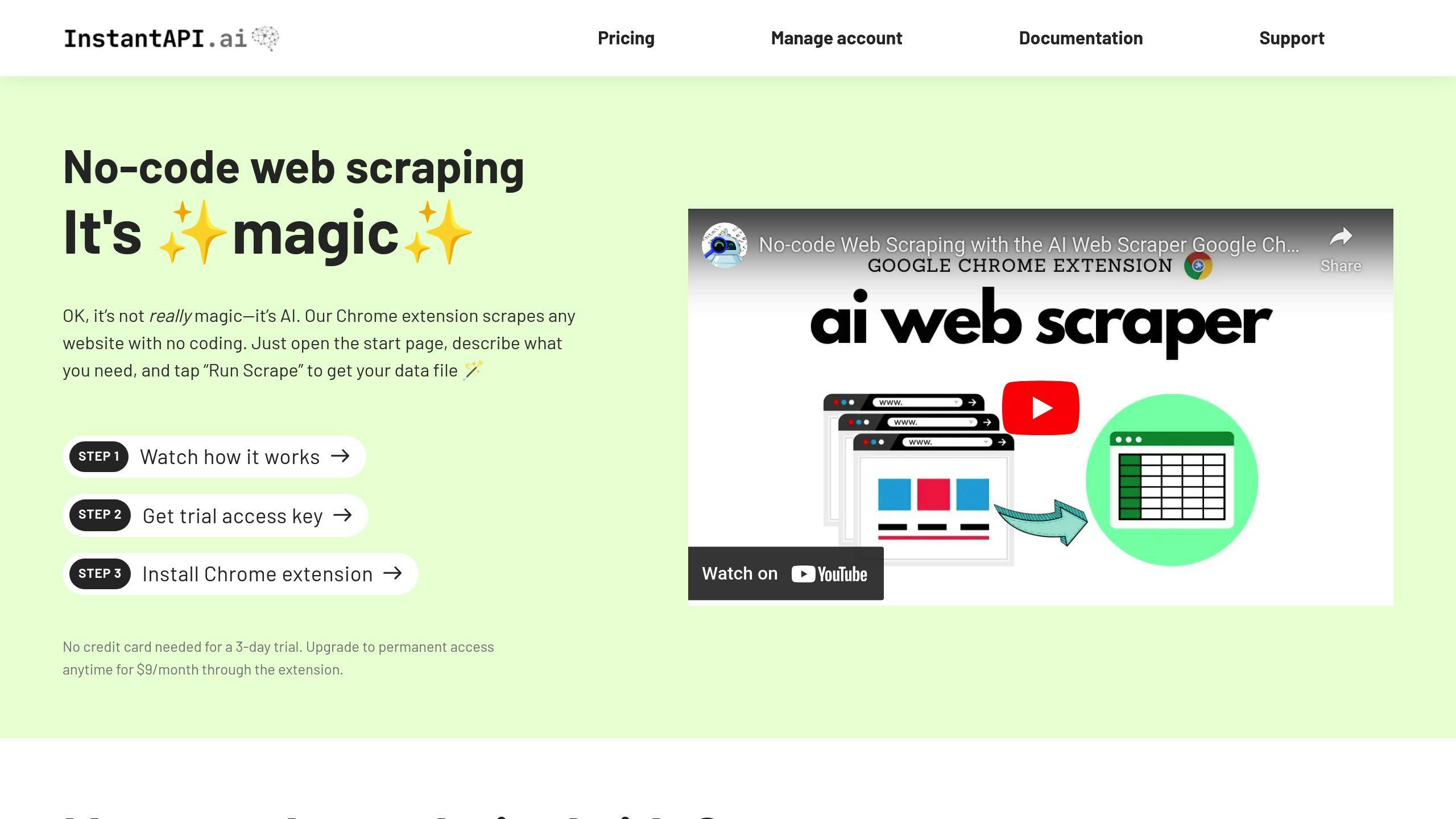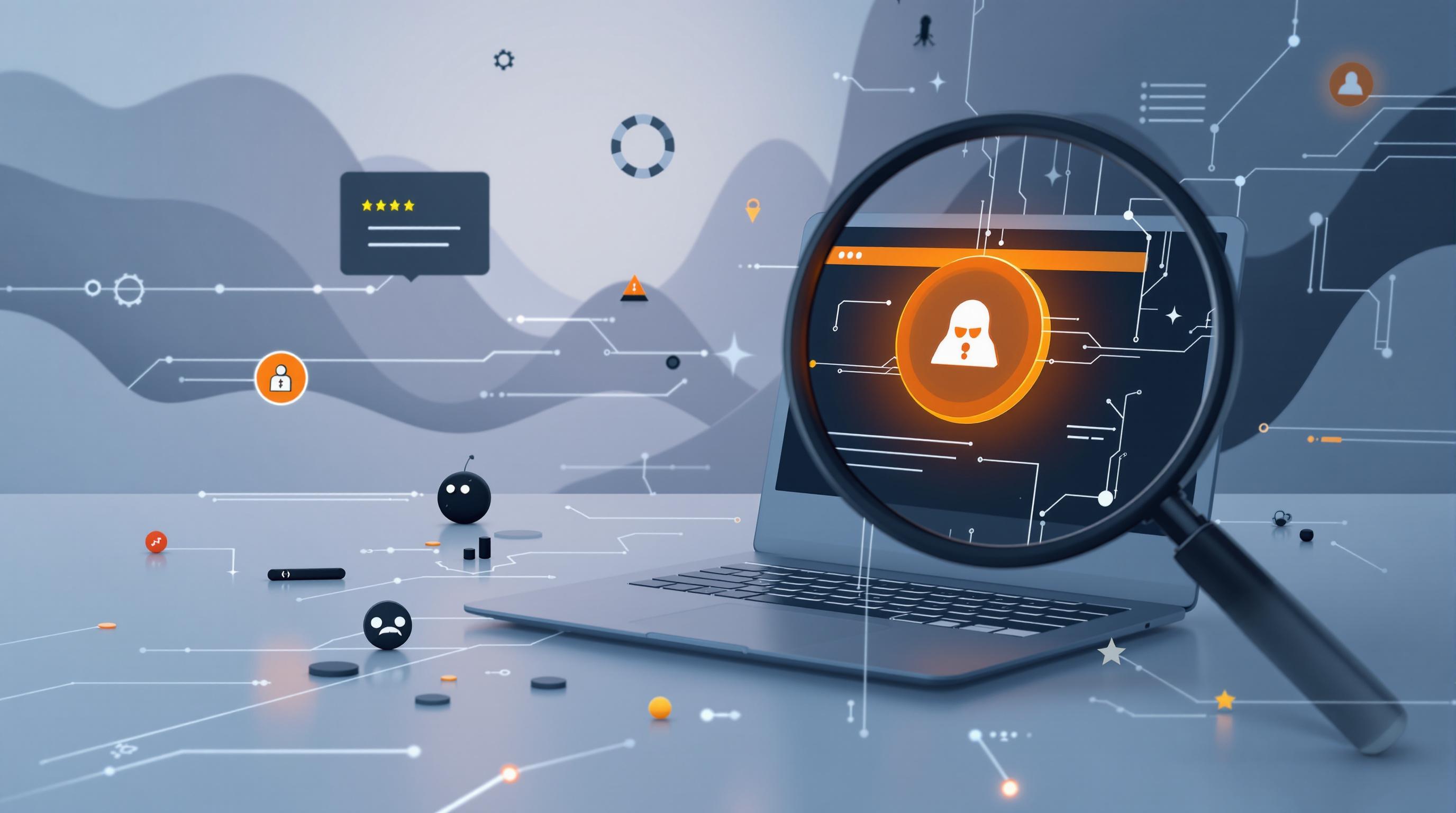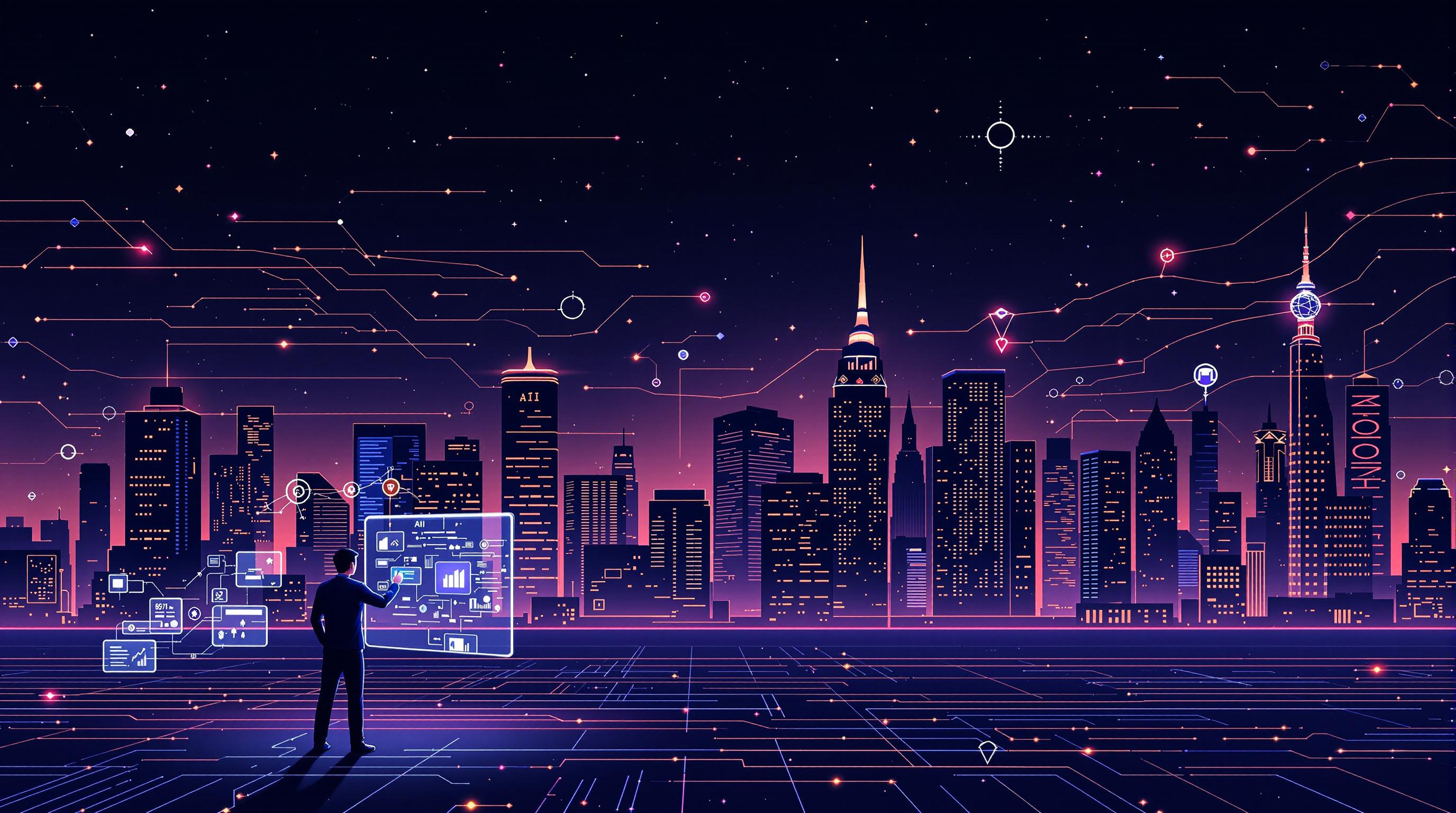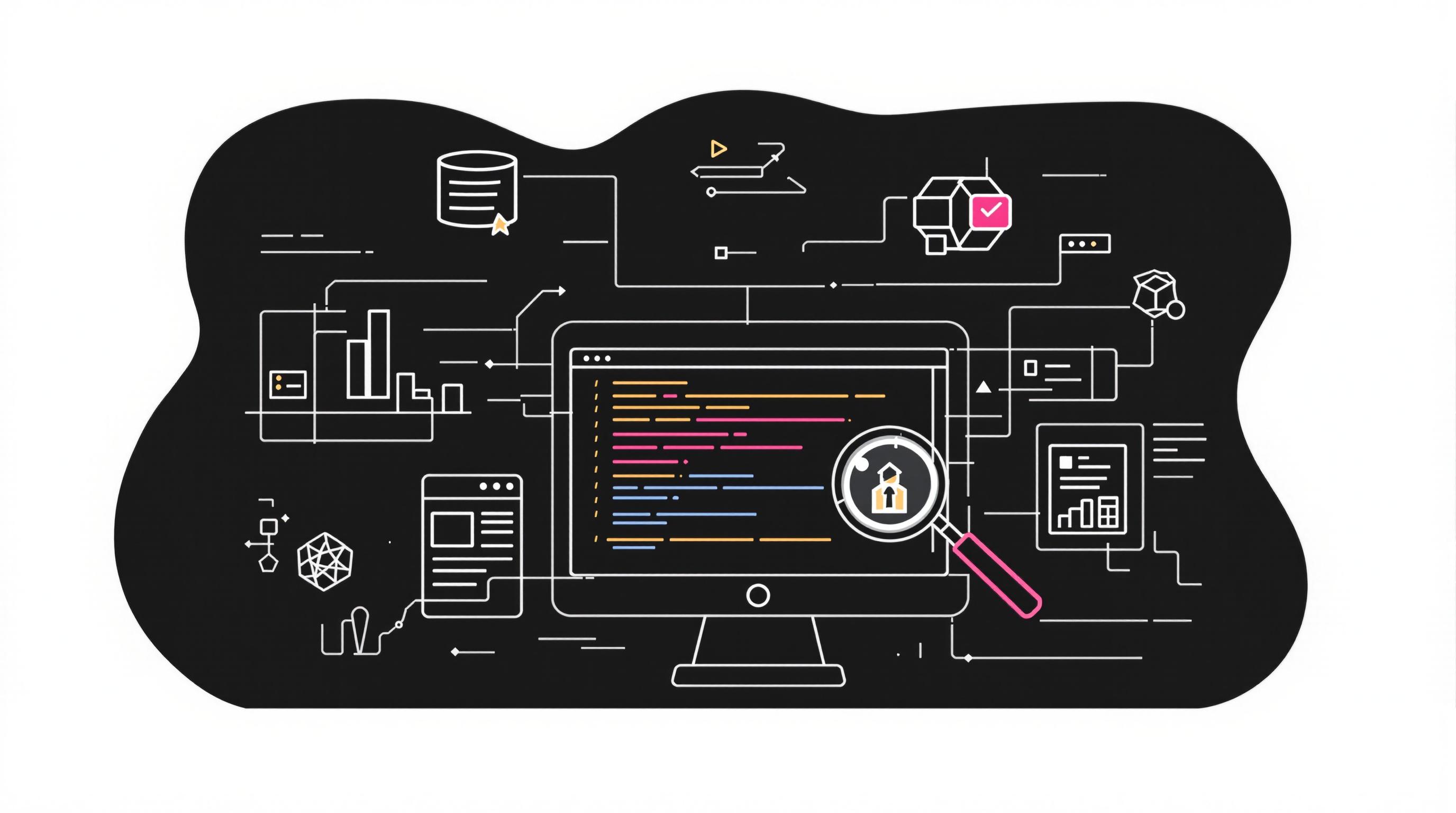AI is transforming web scraping in 2025, making it smarter, faster, and more accessible. With AI-powered tools, businesses can now extract data from dynamic websites, automate updates, and even handle multimedia content - all while addressing ethical and regulatory challenges. Here’s what you need to know:
- No-Code Tools: Platforms like InstantAPI.ai let non-technical users build scraping workflows in minutes without coding.
- Real-Time Data: AI helps track changes like prices or news instantly.
- Multimedia Scraping: Extract data from images, videos, and more with up to 95% accuracy.
- Integration with Analytics: Tools like ScrapingBee enable direct data integration for faster insights.
- Ethical Scraping: Adhering to laws like GDPR and CCPA is key to responsible data collection.
| Feature | Traditional Scraping | AI-Powered Scraping |
|---|---|---|
| Maintenance | Manual updates | Automated adjustments |
| Dynamic Content Handling | Limited | Real-time adaptability |
| Accessibility | Coding required | No-code options |
| Multimedia Data Extraction | Basic | Advanced capabilities |
AI is reshaping how businesses collect and analyze data while navigating challenges like anti-scraping measures and cybersecurity risks. The future is about balancing efficiency, innovation, and ethics in web scraping.
Industrial-scale Web Scraping with AI & Proxy Networks
Trends in AI-Powered Web Scraping
No-Code and Low-Code Web Scraping Solutions
AI-driven platforms like ScraperAPI and ScrapeStorm are making web scraping easier than ever by offering no-code tools. These tools let users build workflows without needing programming skills. For example, InstantAPI.ai has introduced an AI-powered system that eliminates the need for xPath or manual updates. Since launching their drag-and-drop interface in late 2024, they've seen a 200% increase in use by non-technical users.
| Feature | Traditional Scraping | No-Code AI Solutions |
|---|---|---|
| Setup Time | Days to weeks | Minutes to hours |
| Technical Skills | Advanced coding required | Basic computer knowledge |
| Maintenance | Regular manual updates | Automated adjustments |
As these tools simplify workflows, AI is also tackling the challenges of extracting data from dynamic, ever-changing content.
Real-Time Data Extraction from Dynamic Content
Today's AI tools are built to handle dynamic content seamlessly. For instance, ScrapingBee's event-triggered monitoring allows businesses to track price changes, stock levels, and breaking news in real time.
But that's not all - AI's ability to recognize patterns is taking web scraping to a whole new level.
Machine Learning for Pattern Recognition
Machine learning has redefined how web scraping handles pattern recognition. It automates adjustments to website changes, reducing maintenance efforts and costs. ScraperAPI, for example, uses neural networks that achieve a 95% accuracy rate when extracting data from websites with layouts they've never seen before.
These advancements are changing the game for businesses. Companies like InstantAPI.ai are combining these capabilities into unified platforms, making advanced web scraping tools available to organizations of all sizes.
sbb-itb-f2fbbd7
Technologies and Tools for Web Scraping
InstantAPI.ai: AI-Powered Scraping

InstantAPI.ai is a platform designed to simplify web scraping with AI-driven features. It tackles challenges in complex web environments by automating tasks and removing technical hurdles. With tools like unlimited simultaneous requests and built-in JavaScript rendering, it’s built for efficiency.
Here’s what sets it apart:
- Premium proxy management built-in
- Automatic updates powered by AI
- JavaScript rendering engine for dynamic content
- Unlimited concurrent requests for scalability
- No need for XPath configurations
Visual Data Scraping for Multimedia
AI has reshaped multimedia data scraping, making it more accurate and efficient. Tools like ScraperAPI have achieved up to 95% accuracy in extracting information from visual content. These advanced scrapers can handle tasks like analyzing product images, extracting embedded text, processing video metadata, and identifying visual features. This is especially useful for industries like e-commerce and market research.
When paired with analytics platforms, these tools can deliver insights faster, combining data extraction with deeper analysis.
Integration with Data Analytics
ScrapingBee has taken integration to the next level by allowing scraped data to flow directly into popular analytics platforms. This reduces the time it takes to turn raw data into actionable insights by 60%. Businesses can now process and analyze data in real time, making quicker, more informed decisions.
"AI-powered web scraping will move beyond reactive data extraction. Predictive models will identify when specific data points are likely to change, allowing scrapers to preemptively gather information." - PromptCloud, "How Website Data Scraping Will Evolve in 2025?"
While these integrations offer incredible opportunities, they also present challenges, particularly in areas like security and ethical use.
Challenges and Ethics in AI Web Scraping
Dealing with Anti-Scraping Measures
Websites today use sophisticated tools like CAPTCHAs, IP blocking, and browser fingerprinting to block scraping attempts. Tools such as ScrapingAnt counter these defenses with techniques like IP rotation and browser fingerprint adjustments, making it possible to gather data without triggering alarms. Similarly, platforms like ScraperAPI simplify the process by automating proxies, browsers, and CAPTCHA handling, making scraping more efficient than older methods.
That said, as AI systems improve their ability to bypass these measures, they also bring new cybersecurity concerns to the forefront.
Cybersecurity Risks and Solutions
Web scraping now accounts for 36% of website traffic, up from 30% the previous year. HUMAN, a recognized security platform, focuses on distinguishing between legitimate and harmful scraping activities.
"In 2025, content publishers will encounter increasingly sophisticated web scraping attacks as large language models and AI systems evolve their crawling methods." - HUMAN, "The hidden hand of AI: How bots will shape cyberthreats in 2025"
To counter these risks, organizations can adopt several security measures:
| Security Measure | Purpose | Implementation |
|---|---|---|
| Data Encryption | Safeguard scraped information | Use end-to-end encryption during transfer and storage |
| Secure APIs | Block unauthorized access | Apply API key authentication and rate limits |
| Regular Monitoring | Identify breaches early | Deploy automated threat detection systems |
| Proxy Management | Ensure anonymity | Rotate IPs and modify browser signatures |
While cybersecurity is critical, ethical considerations are equally important in web scraping practices.
Ethical Data Extraction
Responsible web scraping means adhering to privacy laws and respecting user rights. Best practices include:
- Transparent Data Policies: Clearly define how data is collected and why.
- Regulatory Compliance: Follow all relevant privacy laws during data collection.
- Consent Management: Obtain explicit permission before collecting personal data.
Organizations should also prioritize anonymization techniques and secure data handling to protect user privacy. Companies like ScrapingAnt show that ethical scraping can balance efficiency with privacy, ensuring data is collected responsibly while maintaining trust.
Conclusion and Future Outlook
Key Points from the Article
AI-powered web scraping has made it easier to handle complex tasks like proxy management and CAPTCHA solving, boosting both efficiency and accuracy. Tools such as ScraperAPI and ScrapingAnt illustrate how AI is making scalable and responsible data collection possible.
No-code platforms have opened the door for small and medium-sized enterprises (SMEs) to access web scraping. Future integrations with predictive AI promise to simplify data strategies even further, allowing businesses of all sizes to implement effective data collection processes.
| Advancement | Current Impact | Future Potential |
|---|---|---|
| AI Pattern Recognition | Automated element identification | Predictive data updates |
| Real-time Processing | Dynamic content extraction | Instant integration with analytics |
| Visual Data Scraping | Basic image extraction | Advanced multimedia analysis |
| Security Measures | CAPTCHA bypass, IP rotation | Enhanced anti-detection systems |
As these technologies evolve, the challenge will be to balance innovation with ethical and regulatory concerns.
Future of AI in Web Scraping
The next phase of AI-driven web scraping will center on two main goals: advancing technology and ensuring responsible use. Predictive scraping models powered by AI can anticipate data changes, allowing businesses to collect information proactively. This will reshape how companies approach competitive intelligence and market trend tracking.
AI tools are also moving toward extracting deeper insights from multimedia content, such as analyzing video sentiment or enabling augmented reality applications. When paired with analytics platforms, these tools will turn raw data into actionable insights more quickly, helping organizations make faster, smarter decisions.
To succeed, companies must embrace these AI advancements while maintaining ethical standards. Trust and compliance will be critical, especially as privacy laws like GDPR and CCPA continue to evolve. The future of web scraping will hinge on responsibly adopting cutting-edge technology while safeguarding privacy and adhering to regulations. Balancing efficiency, security, and ethics will be key to long-term success.


